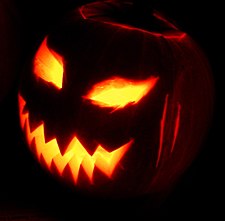Halloween
From Wikipedia, the free encyclopedia
Halloween
Hallowe'en |
|
Halloween |
| Also called |
All Hallows Eve
All Saints' Eve
Samhain
Hallowed End |
| Observed by |
Canada, Ireland, New Zealand, United Kingdom, Japan, Bahamas, United States, sometimes Australia, Sweden, and many Latin American countries where it is known as Noche de las Brujas (Night of the Witches)[1] |
| Type |
Religious, cultural (celebrated mostly irrespective of religion) |
| Significance |
There are many sources of Halloween's significance |
| Date |
October 31 |
| Celebrations |
Trick-or-treating, ghost tours, apple bobbing, costume parties, carving jack-o'-lanterns, bonfires, and fireworks (in Ireland) |
Halloween is a
holiday in many English speaking countries that is celebrated on the night of October 31st. Children wear costumes and they go to peoples' homes saying "Trick or treat!" to ask for candy, sweets in the United Kingdom, or lollies in Australia, and then people give it to them. This practice originally involved a threat.
A threat is when someone says that they will do something bad if they
do not get what they want. In this case the threat could be explained
as: "Give me a treat or I will play a trick on you." Children today
usually do not play tricks if they do not get treats. However, some
children still get up to mischief (pranks or things to make fun of people; like putting toilet paper in trees; writing on windows with soap or throwing eggs at peoples' houses). People sometimes dress up as ghosts, witches, goblins and other scary things for Halloween.
